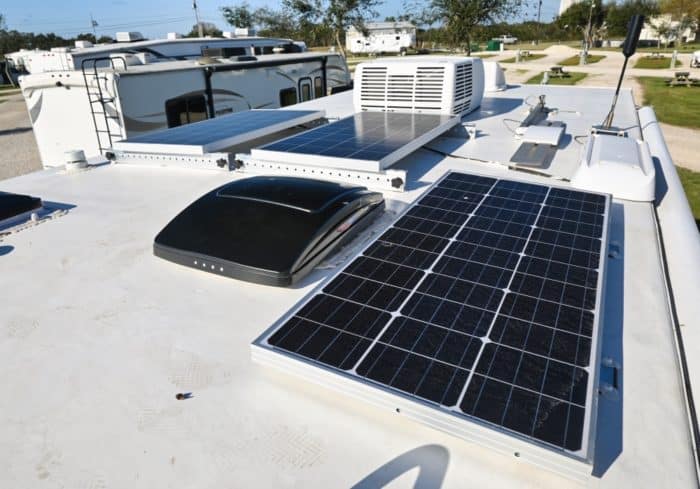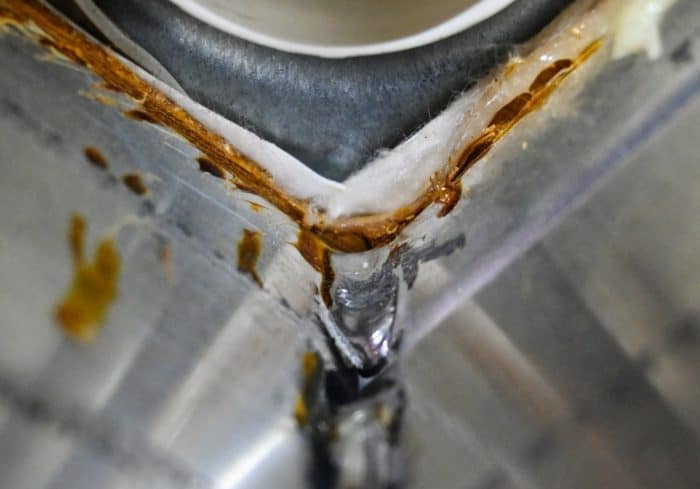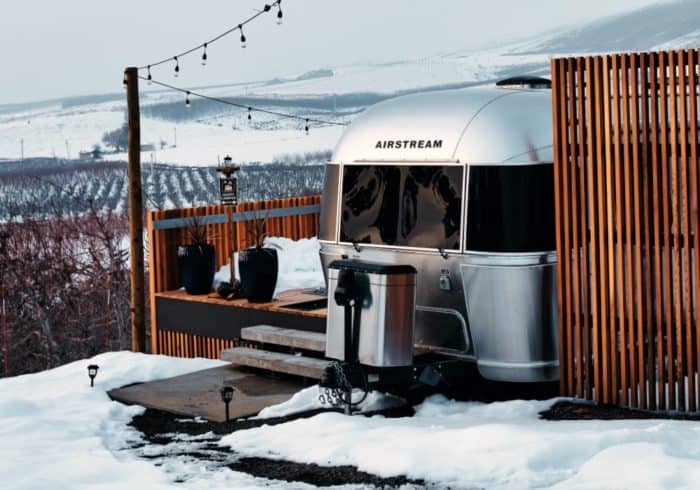The 3 Kinds Of RV Roofs: Rubber, Fiberglass & Aluminum
There are three main materials that RV roofs are made of: rubber, fiberglass, and aluminum.
Each kind of camper roof material has its pros and cons. And it’s important to know what kind of roof your RV has so you know what kind of RV caulks you will need to maintain and repair it.
Related Product: Power an RV AC using a smaller generator using a Hutch Mountain Microair Easy Start (click to view on Amazon)
In this article, I’ll go a little deeper into each kind of roof material and tell you how to tell the difference between them.
If you’re looking to replace your RV roof I’ll go over what the best options are.
Also, if you need to get a new roof or just use sealant to cover and strengthen it.
See Also: Best RV Roof Caulks: When To Use Self Leveling Lap Sealants
Rubber RV Roofs
Rubber is the most common camper roof material. It can be found on motorhomes, travel trailers, and 5th-wheels.
It’s pretty easy to identify but there is a catch. There are actually two different kinds of rubber RV roofs and knowing the difference is really important if you are about to do some maintenance.
The two kinds of rubber used are TPO and EPDM.
Both of these rubbers are used for not only RV roofs but commercial roofing as well. It’s a practical material that’s durable, waterproof, and affordable when compared to other kinds of roofing materials.
When installed on RVs the two look very similar. I’ll go over each kind and tell you a simple way you can tell them apart.
See Also: Best RV Roof Coatings That Seal & Protect (All Camper Roofs)

TPO Rubber Camper Roofs
TPO stands for Thermoplastic Polyolefin. It’s a mix of plastic, fillers, and rubbers.
It’s the most common type of roof installed on RVs, mostly because it’s cheap and good enough to last at least 10 years.
With the proper maintenance, you can get a TPO roof to last up to 15-20 years. Something to think about if your camper has one and you haven’t done anything to maintain it for a while.
See Also: 6 Best Exterior RV Caulks For Camper Window, Molding & Trim
It’s also lightweight which makes it easy to install and it keeps the overall weight of the camper down.
When manufactured, TPO rubber is naturally white. That means it has a natural ability to reflect the sun, stay cool, and reduce UV damage over time.
Pros of TPO Rubber RV Roofs:
- Usually the most affordable RV roof option.
- Good UV resistance due to white coloring and rubber content.
- White on both sides, it will not discolor over time.
- Resistant to mold.
- Waterproof
- Most lightweight roofing option.
- Performs well in both hot and cold conditions.
Cons of TPO Rubber RV Roofs:
- Has the shortest lifespan of all the kinds of RV roofs.
- Requires the most maintenance throughout its life.
- Not all RV caulks and sealants adhere to it.
- Does degrade in the sun over time.
- Not as puncture resistant as other options. (I’ve poked a few holes in my RV’s TPO roof using just a metal scraper)
EPDM Rubber Camper Roofs
EPDM stands for Ethylene Propylene Diene Monomer. It’s a mix of plastics and carbons that result in durable rubber.
It’s a more concentrated rubber material than TPO. In fact, some TPO might have EPDM rubber mixed into it.
Because of the higher rubber content, the heat resistance is very high and it doesn’t break down as easily under harmful UV rays.
It’s highly resistant to scratches and punctures and it adheres well to lots of different kinds of sealants and adhesives which makes it easy to repair.
It has high flexibility and elasticity which makes it great for stretching around RV roof corners and creating a wrinkle free finish that won’t collect dirt and water.
Pros of EPDM Rubber RV Roofs:
- Increased durability and puncture resistance.
- Adheres well to many different kinds of sealants and adhesives making it easy to repair.
- Long and low maintenance lifespan (20 years or more).
- Still pretty lightweight when compared to other roofing materials.
- Naturally very resistant to heat and sun damage. Coloring it white increases these properties.
- Resistant to mold.
- Waterproof
- Very flexible and stretchy.
Cons of EPDM Rubber RV Roofs:
- Must be painted white for RV use.
- May need to be repainted in its lifetime.
- Additional white coloring increases the overall price.
TPO vs EPDM RV Roofs
Color
TPO roofing is naturally white which means no matter how worn it gets it will always keep that color.
EPDM on the other hand is black when it first comes off of the production line. When used commercially it is often kept black since heat absorption can sometimes be a good thing in snowy climates.
For RV use it’s better to have a white colored roof because it increases UV resistance and it reflects heat keeping the inside of campers cooler for longer.
An EPDM RV roof membrane must go through an additional process to color one side white, over time it may start to turn black from regular wear and tear.
It’s fairly easy to make a worn out EPDM roof white again by applying a white sealant paint that not only recolors it but strengthens it and makes it last longer.
Puncture and Scratch Resistance
EPDM is the clear winner in overall strength against tears and holes.
It’s a little too easy to accidentally poke a hole in a TPO roof and it can make it hard to reseal them as you are trying to scrape off the old caulk.
Even though it’s still adequate for most campers the tear resistance of TPO is the lowest of all the kinds of RV roof materials.
If you live or camp in climates that are prone to hail storms I highly recommend getting an EPDM rubber roof over a TPO one.
Weight
Because of the higher rubber concentration, EPDM roofs are a little heavier than TPO ones.
The higher weight makes them a little more difficult to install and increases the overall weight of your camper.
If you are already on the edge of your weight capacity and you are considering upgrading to an EPDM rubber roof you may want to look at the weight first.
Cost
At first glance, TPO and EPDM rubber roofs are very similar in price. But when you look at the RV versions of the two popular roofing materials the price of EPDM goes up quite a bit since it must be painted white.
You could always save a few bucks and get an uncolored rubber roof that’s black, but it’s not recommended for campers.
Black absorbs heat really well. That might be nice for buildings during cold months but for campers that are used mostly in warm weather only, it can make the inside of your camper like an oven.
Overall, white is the optimal roof color for any kind of camper which means if you want an EPDM rubber roof it will need to be painted white which will increase the price.
Which Rubber is Better for RV Roofs TPO or EPDM?
Looking at all the pros and cons, EPDM is still the clear winner in the race for the best kind of rubber RV roof.
TPO is still a fairly new product in the roofing world and it’s being improved upon every year. But for now, it’s not quite up to par with its competitor.
With that being said, the right option for you might be TPO. If you are on a tight budget TPO is still an excellent choice and better than not fixing your camper’s roof at all.
It’s also lighter which makes it easier to install yourself. Just make sure you get the right kind of RV roof caulk (click to see review) that is approved for TPO roof use.
If you are looking to upgrade and you don’t want to go all the way and get an aluminum RV roof, then EPDM is going to be the superior roof over TPO.
I recommend considering the weather in the areas you camp in, what your RV storage is like, and how often your camper’s roof is exposed to the elements.
How to Tell if a Rubber RV Roof is TPO or EPDM
So far the easiest way to tell if your RV roof is TPO or EPDM rubber is to get access to under the membrane to see what color it is.
TPO roofs will always be white underneath or have a fuzzy fleece backing (which will also be white).
EPDM roofs will be black underneath.
The easiest way to access underneath RV roof fabric is to remove the garnish ring on one of the vents inside your RV. The garnish ring is the plastic trim piece that goes around the indent the vent makes.
It’s covering the roof supports which can be wooden or aluminum and possibly hiding some wiring.
Usually, there are just 4 screws you have to remove and you can easily pull it straight down. Make sure you do this slowly so you don’t accidentally yank any wires.
Also, don’t look directly up from underneath it because there’s often a lot of dust and particles that fall out too.

Once you get the garnish ring removed you can normally find a piece of RV roof fabric around the upper edges or corners. Most of the time there will be a lot more extra fabric than what’s in the photo above.
For some reason whoever installed the rubber roof on my motorhome didn’t leave very much extra roof membrane when they cut the holes for the vent.
As you can see in the photo there is a tiny piece of white fabric in the corner. You can see that not only is it white underneath but it also has the fleece backing that is common on TPO RV roofs.
For those reasons, I know this is a TPO rubber roof.
If the fabric had been black underneath that would mean it was an EPDM RV roof.
See Also: How To Easily Replace An RV AC With A Fan, Vent, or Skylight

Fiberglass RV Roofs
Fiberglass is the second most common RV roof material. It’s not nearly as common as rubber RV roofs but you’ll see it a lot more than aluminum.
It’s usually found on pop-up camper roofs and any kind of camper that has a fiberglass shell.
Small travel trailers and truck campers are usually the most common kind of fiberglass shell RV but you will find some small class B motorhomes with fiberglass roofs and siding as well.
See Also: Best Pop Up Screen Tents & Camping Shelters
With that being said, it’s starting to become more common on standard travel trailers and 5th-wheels. If you go check the roof of your new 5th-wheel you might be surprised to find that’s it’s fiberglass and not rubber.
You’ll know it’s fiberglass if it’s a hard shell and not a soft fabric.
What is a Fiberglass RV Roof?
Fiberglass is a strong plastic that’s reinforced with flexible and durable glass fibers.
It can be a flat sheet or formed or molded to create a structural shape.
Most people are used to seeing a fiberglass RV roof in the molded form but the flat sheet version is becoming more common every day.
It makes excellent siding and can be rolled out and easily installed on a flat or curved camper roof.
Fiberglass Roof Features
Durability
Fiberglass RV roofs are very durable. They don’t dent, tear, or get holes poked in them very easily.
It can crack if something hits it hard but it’s also pretty easy to repair.
When talking about resistance against the sun and harmful UV rays it can deteriorate over time if left unmaintained.
It can get dried out by the sun and become very brittle over time. To combat this you can wax or paint your fiberglass RV roof to help it reflect UV rays.
It’s also very waterproof and will hold up very well against harsh weather like hail and heavy rains.
Also, you get rot, mold, rust, and fire resistance.
The lifespan of a fiberglass roof can be 15-20 years if you treat it right. Some can last even longer if stored under a roof and not left to the mercy of the sun.
Weight
When compared to rubber RV roofs, fiberglass is much heavier. When compared to aluminum, it’s a little lighter.
It also depends on the quality of the fiberglass. Some companies use better plastics that can weigh more or you might want to get a thick piece that will also be heavier.
Flexibility & Install
Fiberglass does have some flex to it but you can’t bend it at a 90 degree angle.
That means it won’t be able to wrap down around the sides of your camper like rubber without the help of something called radius foam.
It makes the installation more difficult but the durability can make it worth it in the end to some people.
Cost
Fiberglass RV roofs do cost way more than rubber ones.
It’s usually cheaper than aluminum but not by much, especially when you start looking at the longer 30 to 40 foot rolls of fiberglass.
But the cost can be worth it if you are a full-time RVer who camps in forests where the risk of a stray tree branch damaging your camper roof is higher.
If you camp in the snow a fiberglass roof might save you in the long run since it can help strengthen your RV roof and keep it from collapsing from the weight of heavy snow.
Depending on your camping style the cost could end up being less in the long run.
Fiberglass RV Roof Pros & Cons
Pros
- Very strong and durable against scratches, dents, and punctures.
- Can help strengthen a camper roof and add structure.
- Lighter than aluminum and can be just as strong.
- Bonds well with sealants and adhesives.
- Easy to repair with the right products.
- 15 to 20 year lifespan when properly maintained.
Cons
- Expensive
- Heavy when compared to rubber RV roofs.
- Not super UV resistant but it can be painted or waxed to help it reflect the sun.
- Can’t form around 90 degree RV roof edges. Will need to add radius foam to help it bend.
Fiberglass vs Rubber RV Roofs
Fiberglass is much stronger than the rubber membranes used to cover most camper roofs.
It’s going to hold up better against things like tree branches and hail. It also helps strengthen an RV roof and helps redistribute weight.
The overall durability of fiberglass camper roofs is much better than rubber roofs but there are some reasons why replacing a rubber RV roof with fiberglass might not be the best choice.
RV Life Hack: 6 Things You Can Do To Fix A Broken RV Outlet
First, the cost is much higher not only for the fiberglass but for all of the extra parts you will need to wrap the sides down and things like that.
The installation is also much harder and takes longer with fiberglass and it’s a more difficult material to work with.
In the end, the time and money needed to make the switch just don’t make the pros of a fiberglass RV roof seem as worth it.

Aluminum RV Roofs
Most people associate aluminum RV roofs with Airstream travel trailers. And it’s very true, all Airstreams not only have aluminum roofs, but they also have aluminum sides.
If you have an Airstream camper you can be pretty certain that the roof is aluminum.
But aluminum RV roofs aren’t limited to Airstreams. They can be on other campers as well.
They are especially common on older small (canned ham) travel trailers that have aluminum siding.
It can even be found on older motorhomes.
Durability
Aluminum is a very durable, rust-proof, and weather resistant metal.
It’s very scratch and puncture resistant but one complaint many have about it is the denting. Aluminum roofs and siding does dent pretty easily and it can be difficult to pop the dents back out.
The thickness of aluminum RV roofing isn’t much because the weight needs to be kept to a minimum.
Thin aluminum is still very strong but not indestructible. Holes can be jabbed into it and properly patching aluminum roofs can be complicated.
Some of the lower end RVs that boast an aluminum roof will have super thin sheets on top that aren’t nearly as durable as a high quality thick aluminum RV roof.
One huge benefit is it doesn’t deteriorate in the sun, and it pretty much lasts forever when taken care of.
You can paint it to help keep it looking nice and reflect the sun but an aluminum roof is pretty maintenance free. (You will still need to keep up with the caulk maintenance though)
Weight
Aluminum is one of the lighter metals, but it’s the heaviest RV roof material.
Flexibility & Install
The thicker the aluminum the less flexible it is.
Most standard aluminum RV roofing is 24 gauge, that’s around 0.024 inches. Doesn’t sound like much but it’s enough to keep a camper roof protected against whatever the elements throw at it but be careful about denting it.
The flexibility is going to be similar to fiberglass. If you are replacing fiberglass with aluminum the install won’t be that different. It will just weigh more.
If you are going to replace a rubber RV roof with aluminum (not very common), you will need to plan on adding radius inserts to the sides so you can properly curve it to the drip rail molding or some people just use a hammer the edges until it fits perfectly (not recommended).
Since you can technically bend aluminum to a 90 degree angle it could be an easier install than fiberglass.
Cost
Back in the day aluminum was cheaper than fiberglass but today that isn’t the case.
Fiberglass has become more widespread and since production is up, costs are down.
Usually, the aluminum option will be more expensive, if it’s not, the quality and thickness might be too low to properly protect your camper’s roof.
Aluminum RV Roof Pros & Cons
Pros
- Good Insulator
- Very Durable
- Will not degrade in the sun.
- Can last forever if taken care of.
- Rust Proof
- Mold & Rot Proof
- Fireproof
- Low Maintenance
Cons
- Expensive
- Heavy
- Can dent easily.
- Most difficult to replace or install.
Aluminum vs Rubber RV Roofs
There’s no question that aluminum is by far the most durable and longest lasting RV roof material when compared to rubber.
But you run into some of the same installation issues you would have with fiberglass.
It won’t easily form around the sharp edges of the camper roof which means you will need to insert some radius foam or pound it into shape with a hammer.
I don’t recommend the pounding it to shape with a hammer method because that will weaken the aluminum at the bend and it could potentially crack.
You might not even see the cracks and rain and corrosion will make them bigger over time which turns into a roof leak.
If you are totally gutting an old RV or building your own camper and deciding between the two definitely go with aluminum.
But if you are just thinking about the best replacement for a rubber RV roof I recommend sticking with rubber.
See Also: How To Change An Automatic 2-Stage Dual RV Propane Regulator
Fiberglass vs Aluminum RV Roofs
If you look at overall durability and longevity, quality aluminum camper roofs are better than fiberglass ones.
But if you look at weight, price, and install difficulty; fiberglass could be a better option.
Fiberglass is also easier to repair, it doesn’t expand or compress as much in different temperatures, and adhesives seem to stick to it much better.
Aluminum could technically last forever if taken care of. Fiberglass has a lifespan and it can deteriorate pretty quickly when exposed to UV rays from the sun for too long.
There are so many different pros and cons to each kind of roofing material that it’s really hard to choose a clear winner.
It depends so much on what kind of camper you have and the sort of protection you are looking for.
Aluminum is known to be the material used for higher end campers like Airstreams but fiberglass RVs have their own fanbase and are considered excellent campers.
I think for my wooden framed travel trailer I would have chosen a fiberglass roof because of the lighter weight.
But for my aluminum framed motorhome an aluminum roof seems like the more durable and better option.
Have any questions about RV roofs and the different materials used? Leave a comment below.

